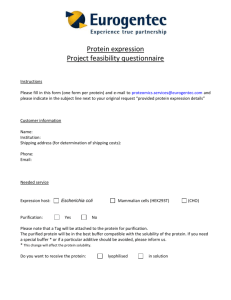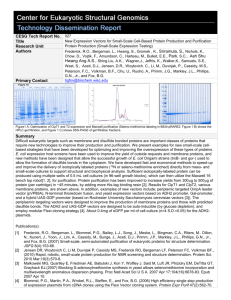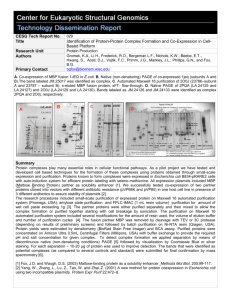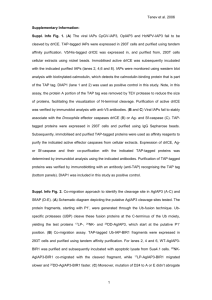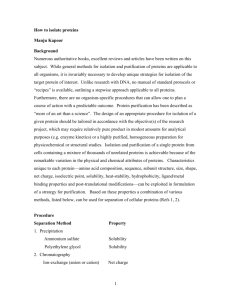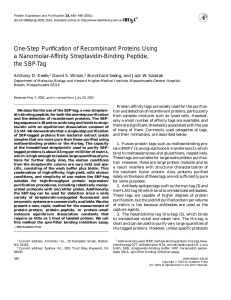x - Center for Eukaryotic Structural Genomics
advertisement
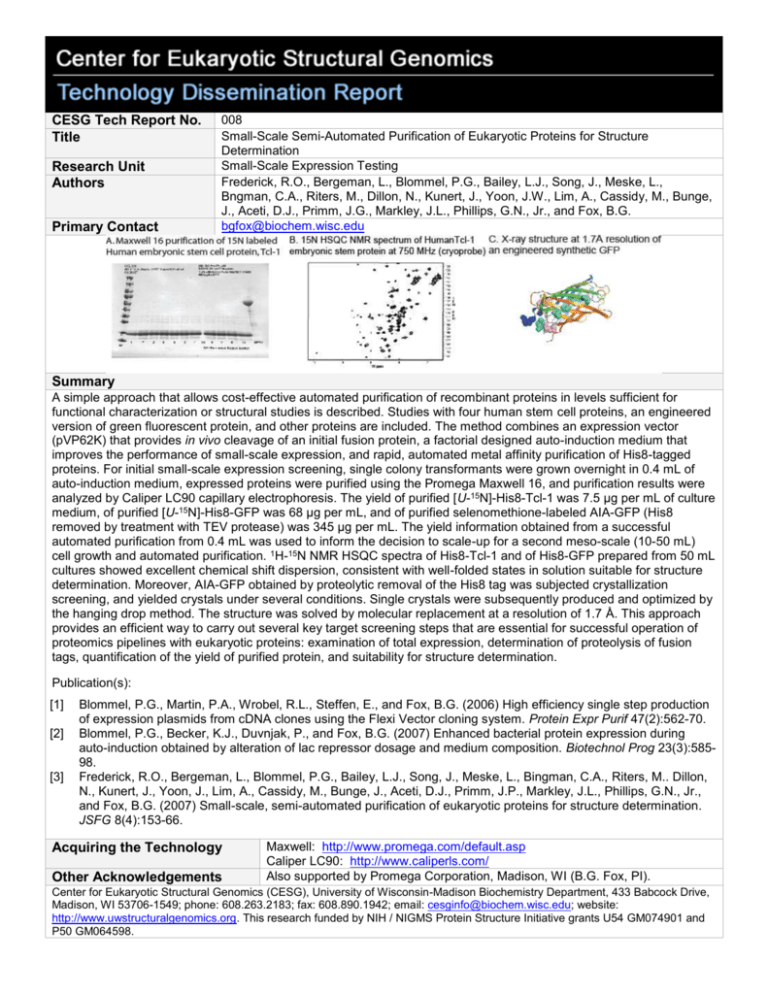
CESG Tech Report No. Title Research Unit Authors Primary Contact 008 Small-Scale Semi-Automated Purification of Eukaryotic Proteins for Structure Determination Small-Scale Expression Testing Frederick, R.O., Bergeman, L., Blommel, P.G., Bailey, L.J., Song, J., Meske, L., Bngman, C.A., Riters, M., Dillon, N., Kunert, J., Yoon, J.W., Lim, A., Cassidy, M., Bunge, J., Aceti, D.J., Primm, J.G., Markley, J.L., Phillips, G.N., Jr., and Fox, B.G. bgfox@biochem.wisc.edu Summary A simple approach that allows cost-effective automated purification of recombinant proteins in levels sufficient for functional characterization or structural studies is described. Studies with four human stem cell proteins, an engineered version of green fluorescent protein, and other proteins are included. The method combines an expression vector (pVP62K) that provides in vivo cleavage of an initial fusion protein, a factorial designed auto-induction medium that improves the performance of small-scale expression, and rapid, automated metal affinity purification of His8-tagged proteins. For initial small-scale expression screening, single colony transformants were grown overnight in 0.4 mL of auto-induction medium, expressed proteins were purified using the Promega Maxwell 16, and purification results were analyzed by Caliper LC90 capillary electrophoresis. The yield of purified [U-15N]-His8-Tcl-1 was 7.5 µg per mL of culture medium, of purified [U-15N]-His8-GFP was 68 µg per mL, and of purified selenomethione-labeled AIA-GFP (His8 removed by treatment with TEV protease) was 345 µg per mL. The yield information obtained from a successful automated purification from 0.4 mL was used to inform the decision to scale-up for a second meso-scale (10-50 mL) cell growth and automated purification. 1H-15N NMR HSQC spectra of His8-Tcl-1 and of His8-GFP prepared from 50 mL cultures showed excellent chemical shift dispersion, consistent with well-folded states in solution suitable for structure determination. Moreover, AIA-GFP obtained by proteolytic removal of the His8 tag was subjected crystallization screening, and yielded crystals under several conditions. Single crystals were subsequently produced and optimized by the hanging drop method. The structure was solved by molecular replacement at a resolution of 1.7 Å. This approach provides an efficient way to carry out several key target screening steps that are essential for successful operation of proteomics pipelines with eukaryotic proteins: examination of total expression, determination of proteolysis of fusion tags, quantification of the yield of purified protein, and suitability for structure determination. Publication(s): [1] [2] [3] Blommel, P.G., Martin, P.A., Wrobel, R.L., Steffen, E., and Fox, B.G. (2006) High efficiency single step production of expression plasmids from cDNA clones using the Flexi Vector cloning system. Protein Expr Purif 47(2):562-70. Blommel, P.G., Becker, K.J., Duvnjak, P., and Fox, B.G. (2007) Enhanced bacterial protein expression during auto-induction obtained by alteration of lac repressor dosage and medium composition. Biotechnol Prog 23(3):58598. Frederick, R.O., Bergeman, L., Blommel, P.G., Bailey, L.J., Song, J., Meske, L., Bingman, C.A., Riters, M.. Dillon, N., Kunert, J., Yoon, J., Lim, A., Cassidy, M., Bunge, J., Aceti, D.J., Primm, J.P., Markley, J.L., Phillips, G.N., Jr., and Fox, B.G. (2007) Small-scale, semi-automated purification of eukaryotic proteins for structure determination. JSFG 8(4):153-66. Acquiring the Technology Other Acknowledgements Maxwell: http://www.promega.com/default.asp Caliper LC90: http://www.caliperls.com/ Also supported by Promega Corporation, Madison, WI (B.G. Fox, PI). Center for Eukaryotic Structural Genomics (CESG), University of Wisconsin-Madison Biochemistry Department, 433 Babcock Drive, Madison, WI 53706-1549; phone: 608.263.2183; fax: 608.890.1942; email: cesginfo@biochem.wisc.edu; website: http://www.uwstructuralgenomics.org. This research funded by NIH / NIGMS Protein Structure Initiative grants U54 GM074901 and P50 GM064598.
